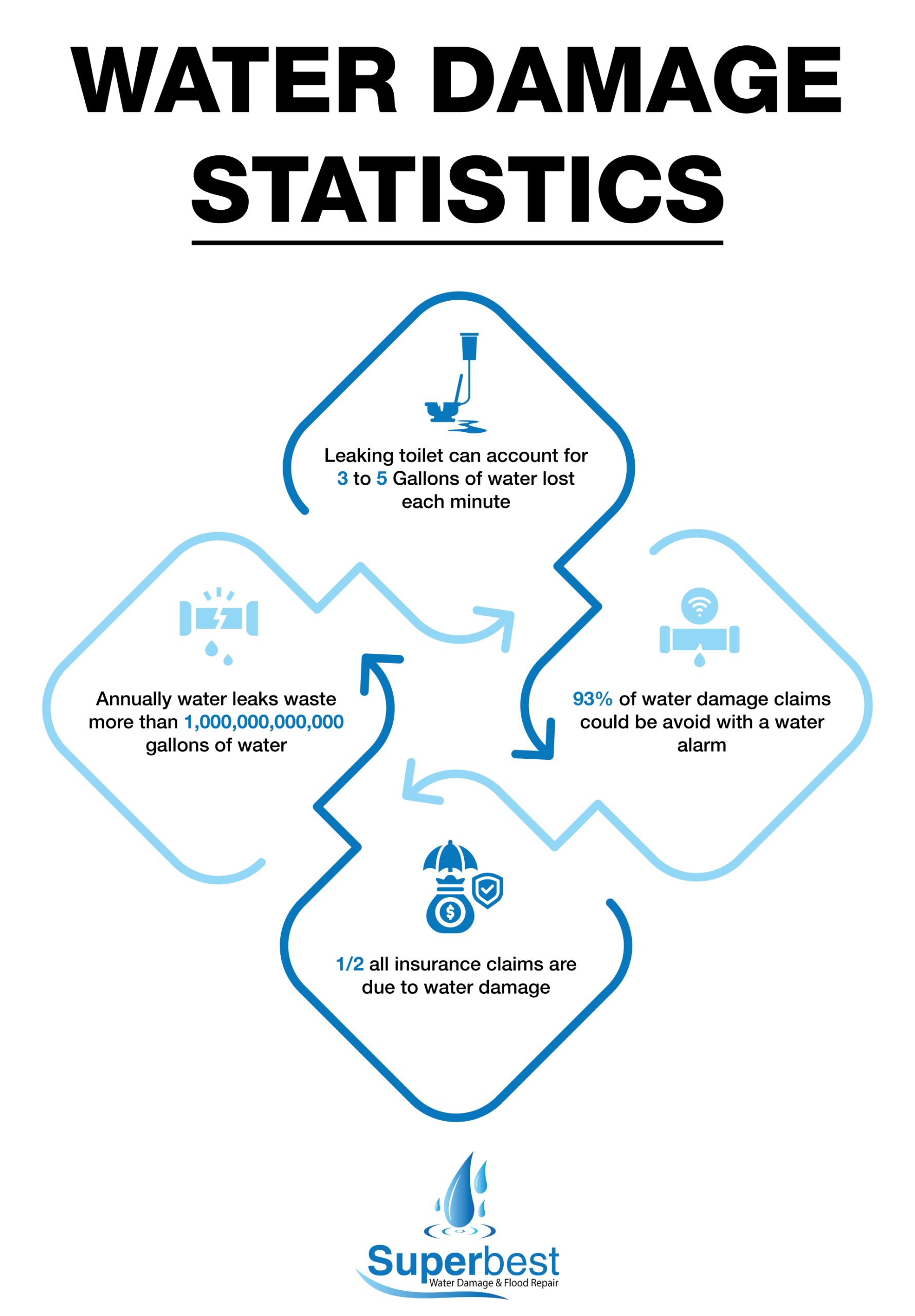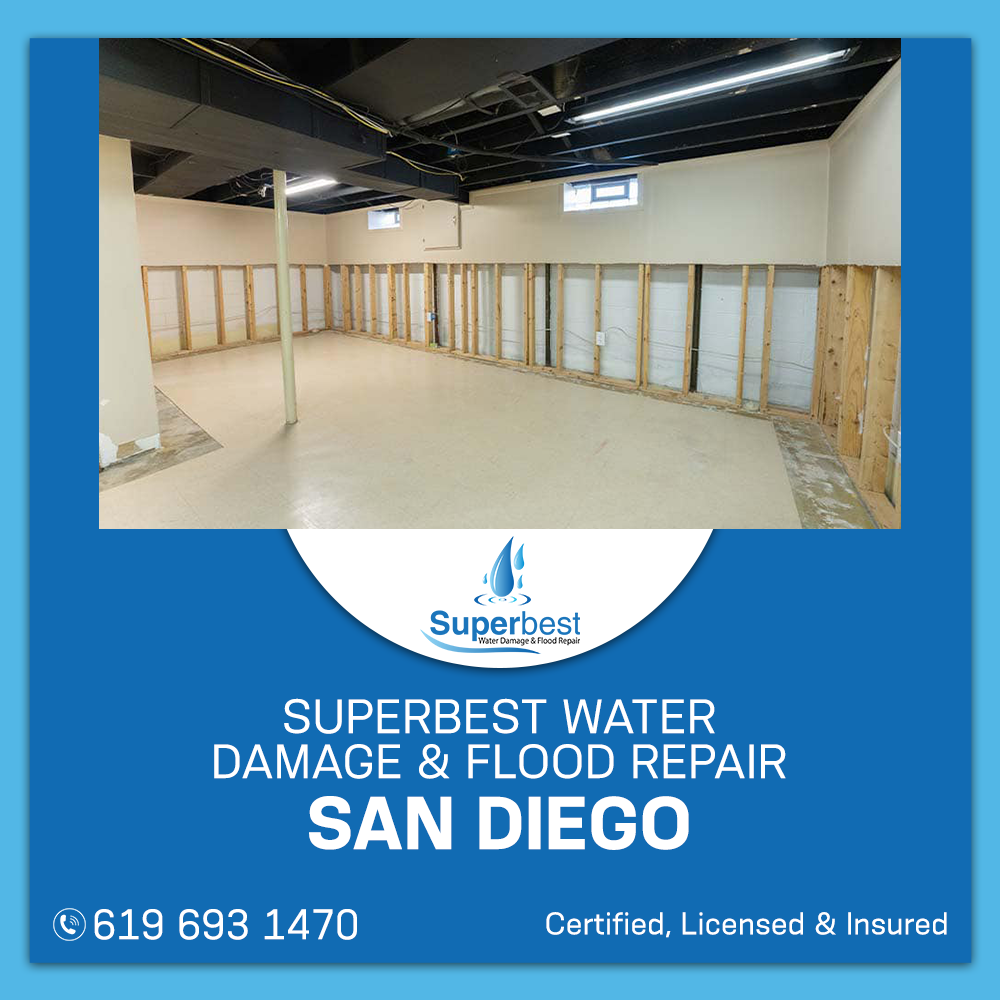Basement Flooding: Mitigation & Drying
San Diego living may be sunny, but sudden indoor floods can turn sunshine into worry. From burst pipes in Del Mar to overflowing appliances in La Jolla, SuperBest Water Damage & Flood Repair San Diego has your back.
We’re experts in tackling any indoor deluge, whether it’s plumbing mishaps, rogue appliance leaks, or accidental sprinkler surprises. Our rapid, 24/7 response team swiftly extracts water, prevents mold growth, and restores your peace of mind with expert repairs. So, when unexpected indoor floods dampen your day, don’t let the worry tide carry you away. Call SuperBest and let us restore your indoor oasis to its dry and delightful best. 
Flooding in a Basement: What to Do (Don’t Panic!)
A flooded basement is a homeowner’s worst nightmare. Waterlogged carpets, ruined furniture, and the looming threat of mold can send your stress levels soaring. But before you break out the scuba gear, take a deep breath and follow these steps to minimize damage and get your basement back in dry shape.
Safety First: Your Top Priority When Facing Indoor Floods
When an unexpected leak or appliance malfunction disrupts your San Diego sanctuary, it’s easy to panic. But before rushing in, remember: Safety First! Taking a few crucial steps can protect yourself and minimize harm while you await the arrival of SuperBest, your trusty water damage restoration heroes.
1. Shut Off the Source: Locate the main water valve, usually near your home’s entry point. Turn it clockwise until the water flow stops. If the leak originates from an appliance, unplug it or flip its circuit breaker.
2. Power Down: Electrical hazards lurk around standing water. Switch off the power at your main electrical panel to prevent shocks or short circuits. If in doubt, leave it to the professionals at SuperBest – their expertise ensures swift and safe power shutoff.
3. Secure the Area: Block off the flooded area with caution tape or cones to prevent accidental slips and falls. Wear sturdy shoes for better grip and avoid wading through standing water, especially if electrical outlets are submerged.
4. Evacuate Pets & Valuables: Move pets and young children to a safe, dry location. If possible, relocate any valuable belongings from the affected area to prevent water damage.
5. Contact SuperBest: Once safety measures are in place, don’t delay! Call SuperBest Water Damage & Flood Repair immediately. Our rapid 24/7 response team is equipped to handle any indoor flood, big or small. We’ll arrive promptly, assess the situation, and take swift action to minimize damage and get your home back on dry land.
Remember, in the face of an indoor flood, prioritize your safety and the safety of others. By following these steps and relying on SuperBest’s expertise, you can navigate the situation calmly and efficiently, turning a watery worry into a dry and delightful outcome.
Let SuperBest be your safety net when indoor floods strike. We’ll handle the water, so you can focus on what matters most – staying safe and returning to your peaceful San Diego haven.
Identify the Leak: Your Guide to Conquering Indoor Floods
Water woes got you down? A hidden leak can wreak havoc in your San Diego haven, triggering worry and disrupting your coastal calm. But before the tide of stress takes over, let’s dive deep and identify the leak, your first step towards restoring peace of mind.
Listen Up: Is there a persistent trickle or a rhythmic drip-drip-drip? These telltale sounds often point to faulty faucets, malfunctioning appliances, or leaky pipes hidden within the walls.
Follow the Flow: See damp spots or warped wood near sinks, showers, or washing machines. These visual clues can lead you right to the source of the leak.
Sniff & Seek: Does a musty odor fill the air? Mold thrives in damp environments, often a red flag for hidden leaks. Grab a flashlight and peer under sinks, behind appliances, and in crawl spaces – mold growth might reveal the culprit.
Check the Meter: Sudden jumps in your water meter reading even with all taps closed? This silent saboteur points to a hidden leak somewhere in your plumbing system.
Unfurl the Toolkit: Invest in a moisture meter or leak detector. These handy tools can pinpoint hidden leaks in walls or under floors, saving you from extensive demolition.
Don’t Go Solo: When in doubt, call SuperBest Water Damage & Flood Repair, your local leak-busting superhero. Our expert technicians are equipped with advanced tools and know-how to quickly locate and conquer any indoor deluge.
Remember, identifying the leak is half the battle. Once you’ve unmasked the culprit, SuperBest is here to swiftly extract the water, prevent mold growth, and restore your home to its pristine, dry state. Let us handle the watery woes, so you can get back to enjoying the sunny San Diego life you deserve.
Hire a professional.
When a sudden flood disrupts your San Diego serenity, choosing the right water damage restoration company can feel overwhelming. You need a team that’s fast, reliable, and equipped to handle any indoor deluge, from overflowing dishwashers in La Jolla to burst pipes in Del Mar. That’s where SuperBest Water Damage & Flood Repair San Diego steps in, your local experts in restoring peace of mind after indoor water disasters.
Why SuperBest?
- 24/7 Emergency Response: We’re there at your moment of need, day or night. We will minimize damage and prevent costly secondary issues like mold growth.
- Expert Diagnosis & Repair: Our certified technicians have the know-how to tackle any source of indoor flooding, from plumbing mishaps to appliance leaks and sprinkler malfunctions.
- Advanced Equipment & Techniques: We utilize cutting-edge technology like industrial-grade water extraction pumps, dehumidifiers, and moisture meters to ensure thorough drying and prevent future problems.
- Open Communication & Transparency: We keep you informed every step of the way, from initial assessment to final restoration, so you know exactly what’s happening in your home.
- Insurance Expertise: We’ll navigate the complexities of your insurance claim, ensuring you get the coverage you deserve for a hassle-free restoration process.
Don’t let an unexpected indoor flood cast a shadow over your San Diego sunshine. Choose SuperBest Water Damage & Flood Repair, and let our expertise bring your oasis back to life. We’ll handle the water so you can focus on what matters most – getting back to your normal routine and enjoying the coastal life you love.
Call SuperBest today and experience the difference!
Contact your insurance company.
There will almost certainly be some flooding that the homeowner will want to notify their insurance company about as soon as possible, and the homeowner will want to see what their flood insurance covers and what they are responsible for.
We remove all the water.
Homeowners can remove excess water from their basements by renting a gas-powered water pump, a pool pump, or even a wet vacuum or pool pump.
Conquering the Damp: SuperBest’s Dehumidifying Power
A flooded basement can leave you feeling like you’ve stepped into an unwanted sauna. The humidity skyrockets, creating a breeding ground for mold and mildew while making the entire space feel clammy and uncomfortable. But fear not, San Diego homeowners! SuperBest Water Damage & Flood Repair steps in as your dehumidifying champion, banishing the damp and restoring your basement to a dry and delightful haven.
Say Goodbye to Soggy Air:
Traditional methods like fans and open windows often fall short in a battle against pervasive basement moisture. That’s where SuperBest’s industrial-grade dehumidifiers come to the rescue. These powerful machines suck the excess moisture right out of the air, transforming your soggy sauna into a comfortably dry space. Imagine the sweet relief of cool, crisp air replacing the oppressive humidity – that’s the SuperBest dehumidifying difference!
Take out all porous materials.
If the damage is severe, there is a wide variety of porous materials, including carpets, rugs, books, clothing, furniture, and even drywall. When drywall stays wet for an extended period, mold can grow inside it.
We dispose of contaminated items.
The items in the basement may be contaminated with harmful bacteria if the basement has been flooded with raw sewage or bacteria. We remove any contents that are affected by category 3 water. Rarely is it possible to salvage something from cat 3 water. A professional can clean items that may smell after a flood if they are not contaminated.
SuperBest responds urgently to our customers experiencing their Basement Flooding with first class Water Damage San Diego, CA.




